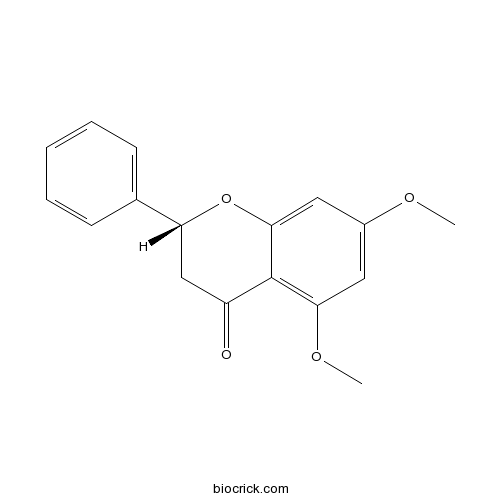(2R)-5,7-DimethoxyflavanoneCAS# 1277188-85-8 |

- 5,7-Dimethoxyflavanone
Catalog No.:BCN3569
CAS No.:1036-72-2
Quality Control & MSDS
3D structure
Package In Stock
Number of papers citing our products

| Cas No. | 1277188-85-8 | SDF | Download SDF |
| PubChem ID | 689012 | Appearance | Powder |
| Formula | C17H16O4 | M.Wt | 284.31 |
| Type of Compound | Flavonoids | Storage | Desiccate at -20°C |
| Solubility | Soluble in Chloroform,Dichloromethane,Ethyl Acetate,DMSO,Acetone,etc. | ||
| Chemical Name | (2R)-5,7-dimethoxy-2-phenyl-2,3-dihydrochromen-4-one | ||
| SMILES | COC1=CC(=C2C(=O)CC(OC2=C1)C3=CC=CC=C3)OC | ||
| Standard InChIKey | IAFBOKYTDSDNHV-CQSZACIVSA-N | ||
| Standard InChI | InChI=1S/C17H16O4/c1-19-12-8-15(20-2)17-13(18)10-14(21-16(17)9-12)11-6-4-3-5-7-11/h3-9,14H,10H2,1-2H3/t14-/m1/s1 | ||
| General tips | For obtaining a higher solubility , please warm the tube at 37 ℃ and shake it in the ultrasonic bath for a while.Stock solution can be stored below -20℃ for several months. We recommend that you prepare and use the solution on the same day. However, if the test schedule requires, the stock solutions can be prepared in advance, and the stock solution must be sealed and stored below -20℃. In general, the stock solution can be kept for several months. Before use, we recommend that you leave the vial at room temperature for at least an hour before opening it. |
||
| About Packaging | 1. The packaging of the product may be reversed during transportation, cause the high purity compounds to adhere to the neck or cap of the vial.Take the vail out of its packaging and shake gently until the compounds fall to the bottom of the vial. 2. For liquid products, please centrifuge at 500xg to gather the liquid to the bottom of the vial. 3. Try to avoid loss or contamination during the experiment. |
||
| Shipping Condition | Packaging according to customer requirements(5mg, 10mg, 20mg and more). Ship via FedEx, DHL, UPS, EMS or other couriers with RT, or blue ice upon request. | ||
| Description | 1. 5,7-Dimethoxyflavanone has anti-inflammatory activity. |
| Targets | TNF-α | IL Receptor | NO | IFN-γ |

(2R)-5,7-Dimethoxyflavanone Dilution Calculator

(2R)-5,7-Dimethoxyflavanone Molarity Calculator
| 1 mg | 5 mg | 10 mg | 20 mg | 25 mg | |
| 1 mM | 3.5173 mL | 17.5864 mL | 35.1729 mL | 70.3457 mL | 87.9322 mL |
| 5 mM | 0.7035 mL | 3.5173 mL | 7.0346 mL | 14.0691 mL | 17.5864 mL |
| 10 mM | 0.3517 mL | 1.7586 mL | 3.5173 mL | 7.0346 mL | 8.7932 mL |
| 50 mM | 0.0703 mL | 0.3517 mL | 0.7035 mL | 1.4069 mL | 1.7586 mL |
| 100 mM | 0.0352 mL | 0.1759 mL | 0.3517 mL | 0.7035 mL | 0.8793 mL |
| * Note: If you are in the process of experiment, it's necessary to make the dilution ratios of the samples. The dilution data above is only for reference. Normally, it's can get a better solubility within lower of Concentrations. | |||||

Calcutta University

University of Minnesota

University of Maryland School of Medicine

University of Illinois at Chicago

The Ohio State University

University of Zurich

Harvard University

Colorado State University

Auburn University

Yale University

Worcester Polytechnic Institute

Washington State University

Stanford University

University of Leipzig

Universidade da Beira Interior

The Institute of Cancer Research

Heidelberg University

University of Amsterdam

University of Auckland

TsingHua University

The University of Michigan

Miami University

DRURY University

Jilin University

Fudan University

Wuhan University

Sun Yat-sen University

Universite de Paris

Deemed University

Auckland University

The University of Tokyo

Korea University
- 9alpha,11-Dihydroxydrim-7-en-6-one
Catalog No.:BCN7225
CAS No.:127681-58-7
- PF-4989216
Catalog No.:BCC6468
CAS No.:1276553-09-3
- Cadherin Peptide, avian
Catalog No.:BCC1018
CAS No.:127650-08-2
- Oleficin
Catalog No.:BCN1848
CAS No.:12764-54-4
- Fananserin
Catalog No.:BCC7440
CAS No.:127625-29-0
- PF-3644022
Catalog No.:BCC6136
CAS No.:1276121-88-0
- HS-173
Catalog No.:BCC5363
CAS No.:1276110-06-5
- CNX1351
Catalog No.:BCC6375
CAS No.:1276105-89-5
- VU 0360223
Catalog No.:BCC6159
CAS No.:1274859-33-4
- Conantokin-T
Catalog No.:BCC5977
CAS No.:127476-26-0
- Calystegine B1
Catalog No.:BCN1882
CAS No.:127414-86-2
- Calystegine B2
Catalog No.:BCN1879
CAS No.:127414-85-1
- Radicicol
Catalog No.:BCC2131
CAS No.:12772-57-5
- SKF 97541
Catalog No.:BCC6626
CAS No.:127729-35-5
- 2'-O-Methylbroussonin A
Catalog No.:BCN7318
CAS No.:127757-13-5
- Dryocrassin ABBA
Catalog No.:BCN6276
CAS No.:12777-70-7
- Saquinavir
Catalog No.:BCC1921
CAS No.:127779-20-8
- C-type natriuretic peptide (1-22) (human, rat, swine)
Catalog No.:BCC6033
CAS No.:127869-51-6
- CGP 37849
Catalog No.:BCC7078
CAS No.:127910-31-0
- CGP 39551
Catalog No.:BCC7053
CAS No.:127910-32-1
- 24(31)-Dehydrocarboxyacetylquercinic acid
Catalog No.:BCN1589
CAS No.:127970-62-1
- CU CPT 4a
Catalog No.:BCC6319
CAS No.:1279713-77-7
- Teucrin A
Catalog No.:BCC8259
CAS No.:12798-51-5
- Ursodiol
Catalog No.:BCC4945
CAS No.:128-13-2
Anti-inflammatory activities of flavonoids isolated from Caesalpinia pulcherrima.[Pubmed:15893896]
J Ethnopharmacol. 2005 Sep 14;100(3):249-53.
The anti-inflammatory activities of five flavonoids, namely 5,7-dimethoxyflavanone (1), 5,7-dimethoxy-3',4'-methylenedioxyflavanone (2), isobonducellin (3), 2'-hydroxy-2,3,4',6'-tetramethoxychalcone (4) and bonducellin (5), all of them isolated from Caesalpinia pulcherrima L. was studied in lipopolysaccharide (LPS) and interferon (IFN)-gamma activated murine peritoneal macrophages. These five compounds significantly and dose-dependently inhibited the inflammatory mediators; nitric oxide (NO), and cytokines [tumor necrosis factor (TNF)-alpha and interleukin (IL)-12]. According to their inhibitory results, the order of anti-inflammatory potency was compounds 3>5>4>2>1. Furthermore, peritoneal macrophages were pre-activated with LPS/IFN-gamma for 24h, and determined the inhibitory effects of the above-mentioned isolates on the production of NO after a further 24h. The present study supports the use of Caesalpinia pulcherrima for the treatment of inflammatory diseases in traditional medicine. This is the first study on compounds 1-5 about their anti-inflammatory activities.


